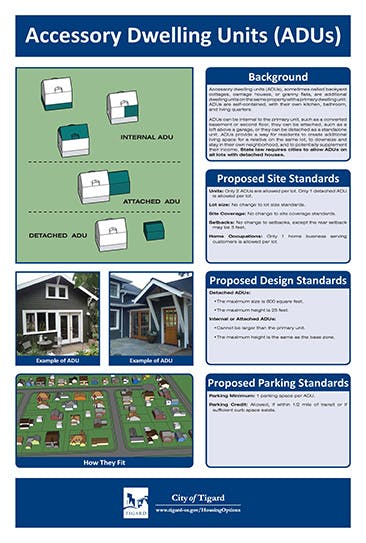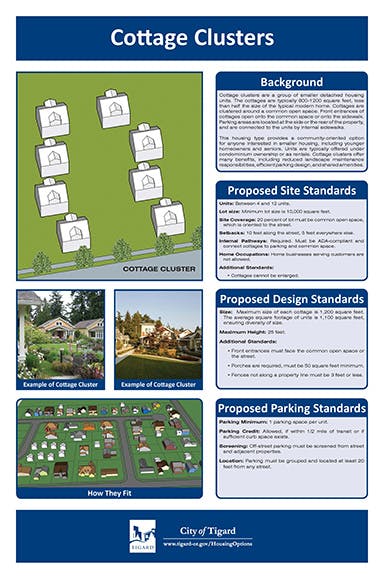Tigard Housing Options
Thank you for your feedback! On November 27, 2018 Tigard City Council approved code amendments to the Tigard Development Code allowing for a wider range of housing types within the city.
The purpose of these policies was to respond to the need for a greater diversity of housing for people at all stages of life. The amendments included standards for “Missing Middle” housing types which have seen increased demand in the market as retirees and younger homeowners are seeking smaller, more vibrant, sustainable, and walkable places to live.
Another purpose of these policies is to create an environment in which construction of a full range of housing types is feasible. This can be accomplished by providing residential zoning districts of varying densities and developing flexible design and development standards to encourage innovation and reduce housing costs.
- - - - - - - - - - - - - - - - - - - - - - - - - - - - - - - - - - - - - - - - - - - - - - - - -

Housing Options for All Stages of Life!
The city is considering a wider variety of housing options for its residents. We want to hear from you about your housing needs and desires.
What types of housing options do you want to see in Tigard?
- "I want to add an Accessory Dwelling Unit (ADU) on my Property."
- "I want to own my own home but yard work has become too much of a hassle."
- "I am looking to downsize but stay in my neighborhood."
- "I want a family member to live near me but not in my home."
The main purpose of this project is to provide for a greater diversity of housing options for all residents regardless of age, income, ability or household size.
Subscribe to learn more about this project and to let us know what types of housing you would like to see now and into the future.
Thank you for your feedback! On November 27, 2018 Tigard City Council approved code amendments to the Tigard Development Code allowing for a wider range of housing types within the city.
The purpose of these policies was to respond to the need for a greater diversity of housing for people at all stages of life. The amendments included standards for “Missing Middle” housing types which have seen increased demand in the market as retirees and younger homeowners are seeking smaller, more vibrant, sustainable, and walkable places to live.
Another purpose of these policies is to create an environment in which construction of a full range of housing types is feasible. This can be accomplished by providing residential zoning districts of varying densities and developing flexible design and development standards to encourage innovation and reduce housing costs.
- - - - - - - - - - - - - - - - - - - - - - - - - - - - - - - - - - - - - - - - - - - - - - - - -



 4 comments
4 comments








